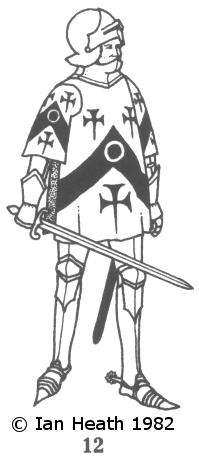
|
WILLIAM FYNDERNE ESQUIRE d.1444
An extract from Armies of the Middle Ages, Volume 1
by Ian Heath
12. WILLIAM FYNDERNE ESQUIRE d.1444
This figure is notably different from the last in that he wears a new variety of surcoat which is usually called a tabard,
identical in style to those worn by heralds (see figure 62).
The tabard appeared in this guise early in the 1420s and lasted until the very end of the century, though it was never worn to the same extent as the earlier jupon had been.
It was worn poncho-fashion, being slit down both sides and usually having flaps at the shoulders instead of sleeves, but it could be tied at the waist by points (see figure 123).
Figure 59 shows a sleeveless version being worn belted at the front but left hanging free at the back like a short cape.
Like the earlier jupon the tabard was normally used to display the wearer’s arms, which in this case are argent,
a chevron between 3 crosses pate fitches sable, an annulet for difference.
His helmet is a sallet (for which see figure 103), here worn with a mentonnière or bevor to protect the neck and chin.
Like the visor (see note 7) this was another item of armour which was often left off and we similarly hear of many men suffering death wounds as a result of its absence.
See back cover.
[Based on the brass of William Fynderne esquire, 1444, Childrey Church, Berkshire, England
Next: 13. HOBILAR, in Armies of the Middle Ages, volume 1 by Ian Heath
|
|

